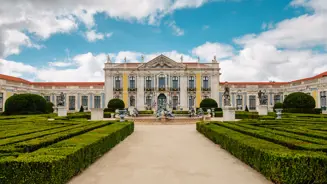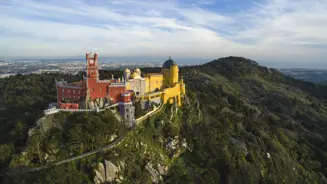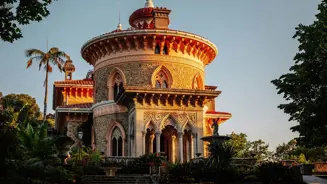Summer in Sintra: the holiday everyone would love to have
01 Aug 2023
August is the month for a holiday for many Portuguese people, but in the days when Sintra's monuments were inhabited, periods of leisure were longer than the typical two or three weeks of rest in summer.
How was the summer season enjoyed in the various palaces of Sintra? Written records offer us a glimpse of how kings, queens and important members of society enjoyed the summer.

At the National Palace of Sintra:
King Duarte (1391-1438) loved to spend long periods of time at the Palace of Sintra during the summer.
In 1435, the king wrote the following: '(...) We come to this town of Sintra many times to have some summers. And so we believe that the kings who come after us will do too, because we find the land of very good airs and waters, and of counties in which there is a great abundance of provisions from the sea and land, and because our very noble and loyal city of Lisbon is so close, and because we have in Sintra a lot of amusement and recreation in the mountains and hunting. And because we have noble palaces in it with very wide views.'
And King Duarte was right: over the years, many monarchs chose to spend the summer in Sintra. Hunting and the mild weather were two of the main attractions for going to Sintra, but the proximity of Lisbon, which over time became the centre of the progressive bureaucratisation of the kingdom's government, also meant that the court decided to confine its trips to a smaller and smaller radius around the main Portuguese city.
Over the centuries, holiday habits changed, but Sintra continued to be one of the court's most popular choices. And with new times came new traditions. One of them is the celebration of Peixe Frito (fried fish).
When the Royal Family came to spend long periods of time in Sintra in the summer, they would organise big parties not only for themselves, but also for the people of Sintra. Peixe Frito was the expression used by the locals to describe the concerts given by the Royal House on the grounds of the Palace of Sintra. These events took place in the summer when the King spent his holidays in Sintra, and were performed by a band that accompanied the court during the summer season.
While it not known when this tradition began, in 1844 there were already reports of it in the Jornal da Sociedade Juventude. According to the report made at the time – recently quoted by Jornal de Sintra – conversations and 'flirtations' were underpinned by the music, the ladies appeared in their most elegant hats, and the gentlemen were described as always walking around with thick cigars to their lips. The Royal Family also attended, but kept to themselves in the Palace, watching proceedings taking place in the courtyard through the windows of the Royal Palace.
'If there is Peixe Frito in the courtyard of the Real Palace, that is, if a regimental band is playing, they will remain there until ten o'clock; if not, they will talk in a group or in some grocery shop,' reads the 1908 work A Estremadura Portuguesa, by the writer Alberto Pimentel, about how summer evenings were lived in Sintra.
After the fall of the monarchy in 1910, the Peixe Frito gradually disappeared.

At the National Palace of Queluz:
Did you know that the Royal Estate of Queluz – now known as the National Palace of Queluz – was the Royal Family's favourite palace to spend the summer months during the reign of Queen Maria I?
They came here to enjoy the good weather, to attend sumptuous feasts organised by King Pedro in honour of St. Peter and St. John, and to celebrate royal birthdays. One thing is certain: there was no shortage of ways to entertain kings, queens, princes, princesses and other distinguished guests.
According to the information gathered by historians over recent few decades, it is known that at this time there were cavalcades, equestrian games and bull fights, with the participation of riders and picadors from the Royal House. People took cart rides in the gardens and gondola rides on the canal.
At night, the gardens and the river were lit up with Chinese lamps and transparent paintings, and the façades of the Palace were illuminated with coloured glass. The Orchestra played in the House of Music on the Canal and artists were hired to entertain the Royal Family and the Court, who also watched the launching of lit balloons richly decorated with paintings.
Throughout the day, dinners, snacks and refreshments were served. After supper, fireworks were launched, producing marvellous effects. Who wouldn't want a summer holiday like that?

At the National Palace of Pena:
This is the time when many enjoy the 'long holidays'. But in the time of King Ferdinand II, the leisure season in Sintra began long before August and lasted longer than the typical two to three weeks that many enjoy nowadays.
As the Diário de Notícias newspaper reports, in the 19th century, the Royal Family would arrive in Sintra at the end of April and stay there for many months, enjoying the good weather and fresh air. Lisbon's wealthiest and most prestigious families would not let themselves get left behind and also chose Sintra as their favourite place to spend the summer season.
'Sintra is expected to be very popular with the elegant world this summer, as many houses have already been rented out, and in recent days quite a few people have come here to enjoy the delights that this pleasant land offers. It is certain that their Majesties will be arriving here throughout this month and will stay for some time. Some objects for their consumption have already arrived at the palace. His Majesty King Fernando shall arrive at his palace in Pena on the 20th of next May. – (From one of our correspondents),' reads the edition published on 20 April 1866.
Sometimes the seasons lasted until October, as happened the following year: 'His Majesty King Ferdinand and His Highness Prince Augusto left the Palace of Pena at 9am today. His Majesty and His Highness have left fond memories in the hearts of all the inhabitants of Sintra, especially those who are less blessed by fortune and who enjoy their protection,' says issue number 825 of the same newspaper, published on 11 October 1867.
Who wouldn't like to take a (very long!) holiday like the Royal Family?
This desire to spend the summer in Sintra was passed down from generation to generation: as well as being the favourite place of King Ferdinand II, Sintra was also one of the places chosen by King Carlos to spend his leisure time.
According to details found in the Letters and Memoirs of Tomaz de Mello Breyner, a doctor in the service of the Royal Family, and from the Memoirs of Chaby Pinheiro, a telegraph assistant, in the summer months, when the Royal Family spent long periods of time at the Palace of Pena, King Carlos I, Queen Amélia and Princes Luís Filipe and Manuel liked to play tennis in one of the parks of this summer residence, descending from the hills to picnic on Praia da Adraga and, after dinner, attending concerts performed by the band that was part of the military detachment that accompanied the Royal Family to Pena.

At the Palace of Monserrate:
And it was not just the Royal Family that liked to spend long periods in Sintra. When he bought Monserrate Estate in 1846, the English merchant Francis Cook immediately realised that this would be the ideal place to spend the summer with his family.
Warmer than London, but cooler than Lisbon or Cascais, Sintra – and Monserrate in particular – had all the conditions for the Cooks to enjoy the summer. And, of course, there was no shortage of English customs that took place there: as well as organising large parties with illustrious guests, this British family liked to maintain the tradition of 'five o'clock tea' in the Music Room or picnics in the open air.
When they returned to London and vacated their property, the Cooks sold entrance tickets to the Park of Monserrate, whose lush gardens were one of its main attractions. The profits were donated to the Santa Casa da Misericórdia de Sintra, essentially to fund schools for young girls, an initiative carried out by Tennessee Claflin, Francis Cook's wife.
After the English merchant's death in 1901, his descendants continued to spend their summers in the palace. Picnics, walks, trips to the beach, bathing in the lake, and garden parties – these all remained festive events at Monserrate into the early 20th century. A 1904 edition of Illustração Portugueza describes the atmosphere: 'One hears laughter, snatches of conversation in English, sees ladies in bright dresses burst into the library, take an interest in the work with the viscounts, and agree to make up a group at the entrance to the house in the shade of the afternoon that the guests of the noble owners enliven with their laughter and conversation (...) the night was filled with stars and, at the end, the illuminated palace was like the dwelling of hospitable, marvellous and opulent fairies.'
